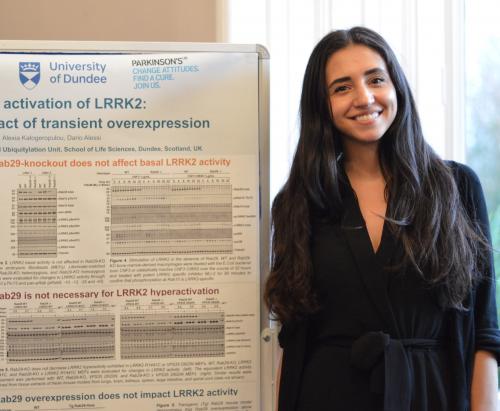
Missense mutations that hyperactivate the LRRK2 protein kinase are a common cause of familial Parkinson’s disease. Recruitment of LRRK2 to membranes leads to its activation, where it phosphorylates a group of Rab GTPase proteins, including Rab10 and Rab12, within the effector-binding switch-II motif.
Earlier studies that we and others have undertaken, suggested that another protein termed Rab29, that is also implicated in Parkinson's, can activate LRRK2 by recruiting it to the surface of the trans Golgi network. Much of this previous work was based on studying how Rab29 impacted LRRK2 activity and localisation in an over-expression system.
Alexia Kalogeropulou, a PhD student supported by Parkinson’s UK in the Alessi lab, was keen to explore the physiological role that endogenous Rab29 plays in regulating LRRK2 kinase activity.
To address this question, Alexia crossed Rab29 knock-out mice with mice harbouring the pathogenic Parkinson’s associated mutation LRRK2[R1441C], as well as with mice harbouring a Parkinson’s mutation in the retromer component VPS35[D620N], that stimulates the LRRK2 signalling pathway by an unknown mechanism. Working with Nicole Polinski at The Michael J. Fox Foundation for Parkinson’s Research, Alexia also characterized a Rab29 transgenic mouse that is now available from Taconic (Taconic Model #16552); click here for further information on this mouse model. Alexia studied the LRRK2 pathway activity in tissues including brain and primary cell lines derived from these mouse models, by measuring LRRK2-mediated phosphorylation of Rab10 and Rab12. Unexpectedly, Alexia found that the basal activity of LRRK2 was not significantly impacted in any of the models that she investigated.
Previously, work by PhD student Jordana Freemantle who undertook a screen of stressors to identify agents that might stimulate the LRRK2 pathway, revealed that antibiotics that belong to the class of monovalent cation ionophores including nigericin and monensin, stimulate LRRK2-mediated phosphorylation of Rab10. Alexia and Jordana established that nigericin and monensin stimulate Rab12 phosphorylation 5-9 fold in mouse embryonic fibroblasts as well as A549 cells, but knock-out of Rab29 had no impact. Alexia also confirmed recent reports that two stressors of the endolysosomal system chloroquine and LLOMe, stimulate the LRRK2 pathway, but here again, this effect was independent of Rab29.
Our data reveal that we do not know as much about how LRRK2 is regulated as we thought we did. In future work, we are keen to explore whether other Rab proteins or regulators that have not yet been characterized, could promote recruitment of LRRK2 to diverse membranes leading to its activation in a similar manner to Rab29 in over-expression systems.
We cannot rule out that LRRK2 activation triggered by Rab29 could occur in a specific cell type or tissue, or following a physiological stimulus, stress or infection that we have not investigated. Rab29 is a relatively poorly abundant Rab and in subsequent studies it would be interesting to explore whether it may play a cell-type specific role in activating LRRK2, for example in macrophages and dendritic cells where it is most abundant.
Our paper also describes two novel Michael J. Fox Foundation monoclonal Rab29 antibodies that we have generated in collaboration with Abcam and characterized in detail and are now commercially available . These antibodies are both against total Rab29 protein, one that is specific for the detection of human Rab29 [MJF-R30-104] (ab256527) and the other is able to detect both human and mouse Rab29 [MJF-R30-124] (ab256526).
Alexia also observed that in brain extracts, Rab12 phosphorylation was more robustly impacted by LRRK2 inhibitors and pathogenic mutations than Rab10 phosphorylation. This has also been observed in other recent studies and emphasises the importance of assessing pRab12 as well as pRab10, especially when analysing LRRK2 activity in the brain.
We thank support from Parkinson’s UK, The Michael J. Fox Foundation for Parkinson’s Research and the UK Medical Research Council for supporting this research
To read a copy of Alexia’s paper click here.

